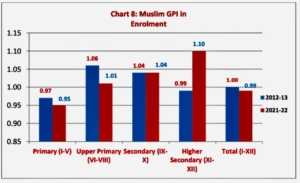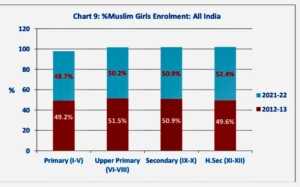Share of Girls in Muslim Enrolment at School Level & Gender Parity Index (GPI)
An Analysis of UDISEPlus 2021-22 Data
This note presents analysis of UDISE data: 2012-13 to 2021-22 with regard to share of girls in the total Muslim enrolemnt at different levels of school education in India.
Tables 13, 14, and 15 present the share of girls to total Muslim enrolment and the Gender Parity Index (GPI) at different levels of education from 2012-13 to 2021-22 based on UDISE data. The data reveals that except for the primary level of education, more girls enrolled than boys at all other levels, and this trend is consistent throughout the period under consideration.
However, at the primary level, the share of Muslim girls is lower than boys, evident for the entire period from 2012-13 to 2021-22, as reflected in the GPI. In the current year, 2021-22, the share of girls to total Muslim enrolment is 48.68 percent, while it was as high as 49.12 percent in the initial year, i.e., 2012-13. Conversely, the share of Muslim boys in primary classes was 51.32 percent in 2012-13. The GPI at this level was also observed at its highest at 0.97 in 2012-13, but after that, it declined to 0.95 (Table 15).
The trend of higher enrolment of girls compared to boys at the upper primary, secondary, and higher secondary levels indicates progress in promoting girls’ education. However, the lower enrolment of girls at the primary level and the declining GPI suggest that there is still room for improvement in achieving gender parity in primary education for the Muslim community. Efforts should be made to address the factors contributing to this disparity and ensure equal access and opportunities for girls’ education at all levels. By promoting gender parity in education, India can build a more inclusive and equitable society for all its citizens.
It is encouraging to see that the share of Muslim girls at all levels above the primary level is higher than boys, and the corresponding Gender Parity Index (GPI) is above 1; this indicates that more girls are enrolled in upper primary, secondary, & higher secondary levels of education compared to their male counterparts. The higher GPI of Muslim enrolment, irrespective of the level, compared to the total enrolment at the all-India level (Table 15) suggests that efforts to promote girls’ education within the Muslim community have yielded positive results.
Table 13: Percentage of Girls at Different Levels of Education to Total Muslim Enrolment, All India: 2012-13 to 2021-22 |
|||||
|
Year |
Primary (I-V) | Upper Primary (VI-VIII) | Secondary (IX-X) | Higher Secondary
(XI-XII) |
Total |
| 2021-22 | 48.68 | 50.20 | 50.91 | 52.42 | 49.69 |
| 2020-21 | 48.80 | 50.58 | 51.66 | 52.15 | 49.91 |
| 2019-20 | 48.87 | 50.83 | 51.81 | 52.45 | 50.03 |
| 2018-19 | 48.92 | 50.90 | 51.74 | 52.16 | 50.04 |
| 2017-18 | 48.90 | 51.03 | 51.59 | 51.95 | 50.01 |
| 2016-17 | 48.99 | 51.33 | 51.93 | 51.95 | 50.14 |
| 2015-16 | 49.05 | 51.35 | 52.09 | 51.65 | 50.17 |
| 2014-15 | 49.02 | 51.49 | 51.74 | 50.85 | 50.08 |
| 2013-14 | 49.12 | 51.38 | 51.21 | 50.24 | 49.99 |
| 2012-13 | 49.22 | 51.48 | 50.94 | 49.64 | 49.97 |
Source: Computed based on UDISE data, different years.
However, the data also reveals two critical points. Firstly, not all girls are currently enrolled in primary grades, indicating that some girls may not be entering the education system or dropping out before completing the primary level of education; this highlights the need for targeted interventions and initiatives to ensure all girls have access to and complete primary education.
Table 14: Percentage of Boys at Different Levels of Education to Total Muslim Enrolment, All India: 2012-13 to 2021-22
| Year | Primary
(I-V) |
Upper Primary
(VI-VIII) |
Secondary
(IX-X) |
Higher Secondary
(XI-XII) |
Total (I-XII) |
| 2021-22 | 51.32 | 49.80 | 49.09 | 47.58 | 50.31 |
| 2020-21 | 51.20 | 49.42 | 48.34 | 47.85 | 50.09 |
| 2019-20 | 51.13 | 49.17 | 48.19 | 47.55 | 49.97 |
| 2018-19 | 51.08 | 49.10 | 48.26 | 47.84 | 49.96 |
| 2017-18 | 51.10 | 48.97 | 48.41 | 48.05 | 49.99 |
| 2016-17 | 51.01 | 48.68 | 48.07 | 48.05 | 49.86 |
| 2015-16 | 50.95 | 48.65 | 47.91 | 48.35 | 49.83 |
| 2014-15 | 50.98 | 48.51 | 48.26 | 49.15 | 49.92 |
| 2013-14 | 50.88 | 48.62 | 48.79 | 49.76 | 50.01 |
| 2012-13 | 50.78 | 48.52 | 49.06 | 50.36 | 50.03 |
Source: Computed based on UDISE data, different years.
Table 15: Gender Parity Index: Muslim Enrolment at Different Levels of Education
| Year | Primary (I-V) | Upper Primary (VI-VIII) | Secondary (IX-X) | Higher Secondary (XI-XII) | Total (I-XII) |
| 2021-22 | 0.95 | 1.01 | 1.04 | 1.10 | 0.99 |
| 2020-21 | 0.95 | 1.02 | 1.07 | 1.09 | 1.00 |
| 2019-20 | 0.96 | 1.03 | 1.08 | 1.10 | 1.00 |
| 2018-19 | 0.96 | 1.04 | 1.07 | 1.09 | 1.00 |
| 2017-18 | 0.96 | 1.04 | 1.07 | 1.08 | 1.00 |
| 2016-17 | 0.96 | 1.05 | 1.08 | 1.08 | 1.01 |
| 2015-16 | 0.96 | 1.06 | 1.09 | 1.07 | 1.01 |
| 2014-15 | 0.96 | 1.06 | 1.07 | 1.03 | 1.00 |
| 2013-14 | 0.97 | 1.06 | 1.05 | 1.01 | 1.00 |
| 2012-13 | 0.97 | 1.06 | 1.04 | 0.99 | 1.00 |
Source: Computed based on UDISE data, different years.
Table 15(A): Gender Parity Index: Total Enrolment at Different Levels of Education
All India
|
Year |
Primary (I-V) | Upper Primary (VI-VIII) | Secondary (IX-X) | Higher Secondary (XI-XII) |
Total (I-XII) |
| 2021-22 | 0.92 | 0.94 | 0.92 | 0.94 | 0.93 |
| 2020-21 | 0.92 | 0.94 | 0.91 | 0.94 | 0.93 |
| 2019-20 | 0.92 | 0.94 | 0.92 | 0.95 | 0.93 |
| 2018-19 | 0.92 | 0.94 | 0.92 | 0.93 | 0.93 |
| 2017-18 | 0.92 | 0.94 | 0.91 | 0.91 | 0.93 |
| 2016-17 | 0.93 | 0.94 | 0.90 | 0.90 | 0.93 |
| 2015-16 | 0.93 | 0.95 | 0.91 | 0.90 | 0.93 |
| 2014-15 | 0.93 | 0.95 | 0.90 | 0.89 | 0.93 |
| 2013-14 | 0.93 | 0.95 | 0.90 | 0.89 | 0.93 |
| 2012-13 | 0.94 | 0.95 | 0.89 | 0.87 | 0.93 |
Source: Computed based on UDISE data, different years. Repeaters have been considered, which are subtracted from enrolment in a Grade.
Secondly, the data indicates that if Muslim girls enroll in the education system, they are more likely to retain and progress from primary to upper primary and subsequent levels; this contrasts with boys, where even though more are enrolled in primary grades, their retention and transition to higher levels of education are not as consistent. This suggests that specific attention should also be given to addressing the barriers preventing boys from continuing their education beyond the primary level.
While the current data provides valuable insights, a more comprehensive understanding of participation rates can be obtained through the enrolment ratio, which, unfortunately, is not available from official sources. Improving data collection and reporting will be essential to track progress accurately and design targeted interventions to further enhance education access and retention for both boys and girls, especially at the primary level. By ensuring equal opportunities for education for all children, regardless of gender, India can make significant strides toward achieving a more equitable and inclusive society.
Muslim Gross Enrolment Ratio at School Education in India (2021-22)
State-wise Muslim Gross Enrolment Ratio at School Education in India (2021-22)
Muslims Gross Enrolment Ratio at Higher Education Level (2020-21)
Muslim Gender Parity Index at Higher Education Level in India, 2016-17 to 2020-21
Average Annual Growth Rate: Muslim Enrolment in Higher Education
Share of Muslim Enrolment in Higher Education in India: 2016-17 to 2020-21
Number of Muslim Children Dropped-out between 2020-21 & 2021-22 in India
Muslim Students Transition Rate in India: Cohort 2018-19 to 2020-21
Muslim Students Retention Rate at Primary, Elementary & Secondary Levels, Cohort 2020-21





